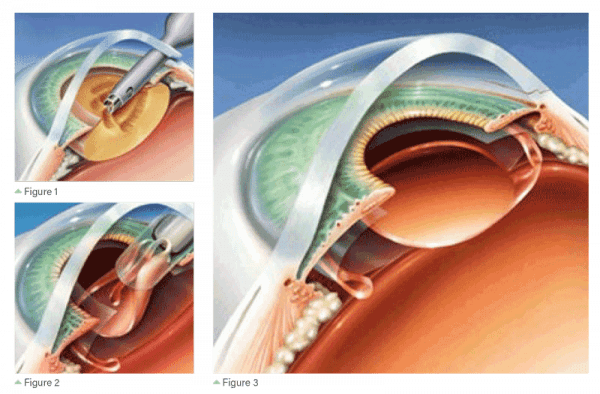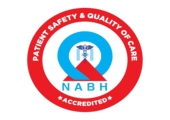Understanding cataract surgery :
A cataract is the clouding or opacification of the crystalline natural lens that is present in the human eye. the lens is situated in the eye behind the iris in a capsular bag. This lens is transparent allowing light rays to be focussed on the retina, which is a sensitive layer in the eye that forms an image. This lens is made up of proteins, enclosed in a capsule. Due to ageing and various other reasons, there occur different changes in the lens proteins causing opacification of the lens, which is called CATARACT, causing visual disturbance. Standard treatment for this cataract surgery.
In cataract surgery, the natural lens is removed, replaced with an artificial intraocular lens for restoration of vision. this removal of cataracts is done through various techniques and many developments have occurred in the technique of cataract surgery in the last few decades. In recent years, many changes in the cataract surgery technique have helped in minimal tissue injury surgery, thus helping for early healing and early visual recovery. One such development is phacoemulsification surgery for cataract surgery.
Phacoemulsification Surgery:
Phacoemulsification surgery was first developed by Dr. Charles Kelman in late 1960. In phacoemulsification surgery, a small incision of about 2-3 mm is done in the cornea. Through this small incision, the front part of the lens capsule is removed. Then using ultrasonic probes which have a frequency of about 40,000 Hz, the cataractous lens is emulsified and is directly aspirated with the same probe. Earlier, this cataractous lens was removed manually through incisions of about 7mm. Such a technique is called small incision cataract surgery.
But in phacoemulsification surgery, the lens is cut into pieces with an ultrasonic probe and aspirated, which is done through a 3 mm incision. Once the lens is removed, a foldable artificial intraocular lens is implanted. The foldable intraocular lens is inserted through this 3 mm incision, which unfolds in the lens capsular bag. Since the incision is as small as 3 mm in phacoemulsification surgery, incisions are self-healing and hence do not require sutures. Small incision, less tissue injury, faster procedure and foldable intraocular lens make phacoemulsification surgery a safer procedure. Many advances and improvements have been developed in phacoemulsification surgery and intraocular lens in recent years.

Recovery after phacoemulsification cataract surgery
In the few hours after phacoemulsification cataract surgery :
- As cataract surgery is day care surgery, the patient will be discharged in one or two hours after cataract surgery. mild headache, giddiness is common in a few patients, especially in patients with systemic diseases.
- once you reach home, the patient is advised to rest for a few hours. in most instances, patients do not have any restrictions on food and hence you can have regular food. depending on the type of anaesthesia used during cataract surgery, there may be a bandage over the operated eye.
- you can remove the bandage as per your doctor’s advice on your own after washing your hands.
- you will be prescribed a few eye drops which you can start immediately after removing the bandage.
- it may take a few hours to days for your complete recovery of vision after cataract surgery. you might notice an imbalance in vision between your eyes if the other eye has a cataract.
Medications after cataract surgery :
Post cataract surgery, eye drops are prescribed to control infection, and inflammation in the operated eye for about one month to 6 weeks usually. these eye drops consist of antibiotics, and steroids, the dosage of which are to be followed as per your doctor’s instruction. in a few cases, there might be additional medications given based on the eye condition. shake drops of the bottle well before using. give 10 minutes gap in between using two drops. the patient himself can be encouraged to use eye drops, as this will reduce dependency on others.
Days after cataract surgery: course and precautions to be taken
- vision will usually begin to improve in a few hours or days after cataract surgery unless your eyes have any other disease which is affecting vision.
- It is normal to have some kind of itching, foreign body sensation, and watering of the eye in the initial few days. this will be reduced in a few days.
- using dark glasses is advised initially as bright light might cause some disturbance or intolerance. using dark glasses makes you feel better. however, you can replace dark glasses with any protective glasses after 3-4 days if you are comfortable seeing light.
- you can resume regular activities after 1-2 days based on how comfortable you feel. most patients are advised resume to regular activities after 1-2 days.
- watching television, mobile, and laptop can be resumed in 3-4 days in most cases. you might need reading glasses after cataract surgery if you have got a mono-focal intra-ocular lens implanted. you can start reading after your doctor gives you a reading glass prescription.
- do not rub your eyes for 1 week. if watering is present, you can wipe with clean wipes or a cloth.
- avoid rigorous exercises and heavy weight lifting. however regular exercises and walking can be started in 3-4 days if you are comfortable.
- stay away from dusty areas, this will avoid the possibility of infections, and allergies to your eyes.
- driving can be started based on how is the healing of the operated eye and based on other eye statuses. you can resume driving as per your surgeon’s advice
- other household activities, cooking can be resumed after your doctor’s advice, based on your eye healing. advised to wear protective glasses for all such activities, for 2 weeks.
- you can continue other medications you’re taking for systemic diseases.
- use eye drops prescribed after cataract surgery as per schedule strictly, till your doctor’s advice.
- swimming can be avoided for 1-2 weeks. wearing of eye makeup is to be avoided for 1 -2 weeks. start all these activities after your doctor’s advice, based on your eye healing.
- however, all these above instructions can be different, based on your eye healing, and surgery. you can confirm all these instructions with your doctor once.
Concerns to be addressed or keep watch for :
- A few symptoms in the operated eye such as pain in the eye, any decrease in vision, or redness in the eye needs to be addressed immediately. you can contact your ophthalmologist immediately in case of such symptoms.
- In case you experience vomiting, nausea, or severe headache, contact your ophthalmologist immediately and seek the necessary help.
Phacoemulsification is one of the most commonly performed eye surgery. With the advent of technology, visual recovery is faster as there is minimal tissue injury. Most of the time, cataract surgery recovery is smooth. Proper care and following your ophthalmologist’s advice can make your recovery easy. all the above guidelines are in general, however, your condition may differ, strictly follow your ophthalmologist’s advice.






